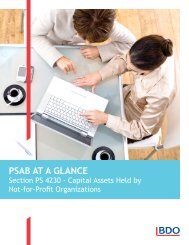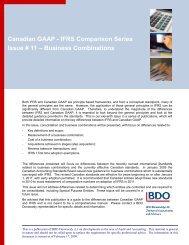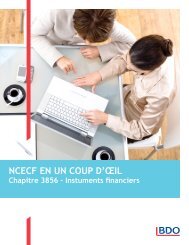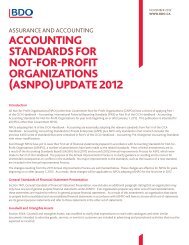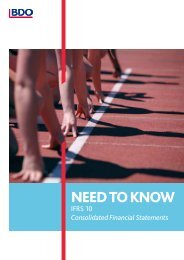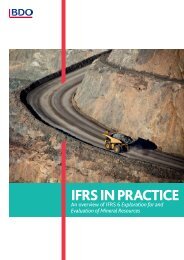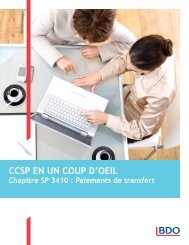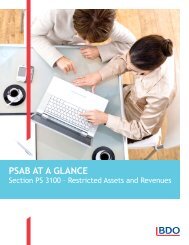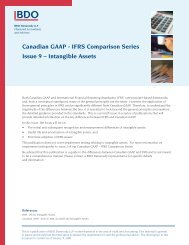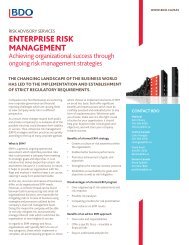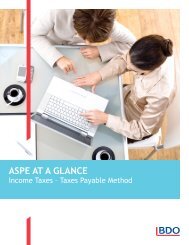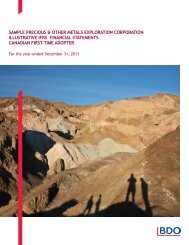need to know / leases - project update - BDO International
need to know / leases - project update - BDO International
need to know / leases - project update - BDO International
Create successful ePaper yourself
Turn your PDF publications into a flip-book with our unique Google optimized e-Paper software.
10 LEASES - A PROJECT UPDATE<br />
Subsequent accounting<br />
The subsequent accounting would depend on the nature of the underlying asset. There would be two types of <strong>leases</strong>, with<br />
the classification being based on the extent of consumption of the leased asset during the lease term.<br />
Determining the type of lease<br />
The two proposed types of <strong>leases</strong> are:<br />
––<br />
The finance approach (or the interest and amortisation approach, or accelerated expense approach)<br />
––<br />
The straight line approach.<br />
While this would appear similar <strong>to</strong> the current finance vs operating lease distinction, the distinction between the two types<br />
of lease under the proposals would be different.<br />
The underlying principle in distinguishing between the approaches would be based on whether the lessee acquires and<br />
consumes more than an insignificant portion of the underlying asset over the lease term. If it does then the transaction<br />
would be looked at as a ‘financing transaction’ and the income statement would reflect a pattern of financing income or<br />
expense.<br />
The principle would be applied using a practical expedient based on the nature of the underlying asset, such that <strong>leases</strong> of<br />
property (including land and/or a building or part of a building) would be accounted for using the straight line approach<br />
unless:<br />
––<br />
The lease term is for the major part of the economic life of the underlying asset; or<br />
––<br />
The present value of fixed lease payments accounts for substantially all of the fair value of the underlying asset.<br />
Leases of assets other than property would be accounted for using the finance approach (accelerated expense) unless:<br />
––<br />
The lease term is an insignificant portion of the economic life of the underlying asset; or<br />
––<br />
The present value of the fixed lease payments is insignificant relative <strong>to</strong> the fair value of the underlying asset.<br />
During an IASB webcast in July 2012, the Staff presented a slide with the following examples:<br />
Truck (4 years) 3<br />
Vessel (20 years) 1 Vessel (5 years) 1<br />
More than Insignificant<br />
Car (3 years) 4<br />
Commercial property<br />
(30 years) 1<br />
Insignificant<br />
Commercial property<br />
(10 years) 1<br />
Aeroplane (8 years) 2<br />
Assumed economic life:<br />
1. 40 years 2. 25 years 3. 10 years 4. 6 years<br />
<strong>BDO</strong> comment<br />
It would appear that most <strong>leases</strong> (except for <strong>leases</strong> of real estate) would be regarded as being for more than an insignificant<br />
portion of the underlying asset and would therefore be accounted for under the finance approach. For example, the slide<br />
indicates that, if a the lease term of a vessel is five years and the assumed economic life 40 years, the staff believes that there<br />
is <strong>need</strong> for further judgment since this might suggest that the lessee consumes more than an insignificant portion of the<br />
underlying asset over the lease term.



